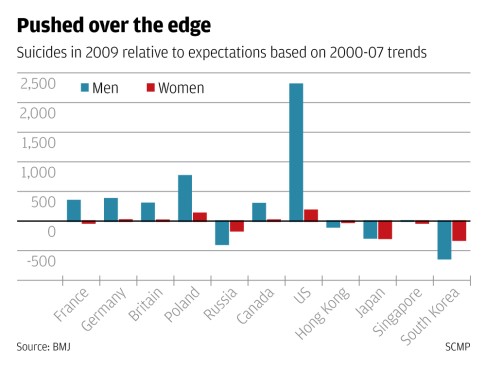
2008 financial crisis led to surge in suicides, international study finds
5,000 more globally killed themselves in wake of lay-offs, study finds
The 2008 global financial crisis and mass lay-offs in its wake might have driven 5,000 more people than expected globally to commit suicide in the following year, according to a study.
In 18 countries in the Americas the study covered, 3,500 more people killed themselves than would normally be expected. In 27 European countries, the figure was almost 3,000.

But in Asia there were around 1,600 fewer suicides than expected, according to the research, released yesterday by medical and educational institutions from Hong Kong, Taiwan and the UK.
Paul Yip Siu-fai, of the University of Hong Kong's Centre for Suicide Research and Prevention who took part in the study, said the findings appeared to be linked to rising rates of unemployment caused by the financial crisis.
In Hong Kong, 114 fewer people than expected took their lives.
The study covered 54 countries from Europe, America, Asia and Africa, comparing suicides in these countries in 2009 with the expected numbers based on suicide trends between 2000 and 2007.
The suicide data came from the World Health Organisation's mortality database and the online database of the Centres for Disease Control and Prevention in the US. More than 5,100 of the excess suicides were men; 240 fewer women than expected had killed themselves.
According to the study, the jobless rates in European countries were up to 35 per cent higher in 2009 than in 2007, while there was a 94 per cent rise in North America.
The US suffered the most from this trend, the study shows, with almost 2,500 excess suicides, the highest of any country.
Yip said the crisis seemed to have affected young people in Europe and middle-aged people in America more, with the suicide rates among them the highest in all age groups. He said this was also related to the unemployment rates among these two groups, which are also higher than in other age groups.
"Young people often feel hopeless without a job, while middle-aged people often find it hard to adjust after losing a stable job," he said.
"Employment means more than having a job. It also gives a meaning to life."
Yip suggested that companies inform staff about impending job cuts more skilfully, give them more time to prepare and offer help when necessary.
Hong Kong was not so vulnerable to the effect. The suicide rate had fallen since 2003, when it reached a peak of almost 19 suicides per 100,000 people due to the double blow of severe acute respiratory syndrome and the ongoing impact of the Asian financial crisis, according to Yip.
He said although the study suggested Hong Kong's economy had been robust in the face of the 2008 crisis, the city had other problems to solve. Last year the suicide rate edged up to 11.6 per 100,000 people, compared with 10.6 the year before.
Yip said more women than men have been committing suicide in Hong Kong, and many of them were from poor or broken families.
He urged the government to help the underprivileged.
"When a financial crisis strikes, these groups will be the most easily affected," he said. "The government should protect the weakest in society to prepare for any possible crisis in the future."
The increase in suicides was mainly among those aged 18 to 24 who were struggling to find jobs and cope with soaring property prices, said Yip. "There has been a heavy sense of helplessness in society."
Also, he said, many people were working long hours but felt they were not receiving an appropriate level of pay for their efforts.

